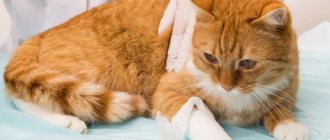The cat is a very active pet. He loves to climb trees, jump, get into hard-to-reach places, and even sometimes fight. But such pranks do not always end well; the cat quite often inflicts various injuries on itself.
One of the most common problems affecting our furry friends is ear disease. How to determine the location of an injury or understand the cause of your cat's anxiety? First you need to observe the symptoms.
Symptoms
If your cat has swollen ears, the following symptoms may appear:
- elevated temperature;
- odor from the ear;
- redness or swelling of the skin;
- the cat walks with its head tilted, shakes or twitches it, scratches its ears with its paws.
There may be several reasons why a cat's ear is swollen. Let's look at the main ones.
How to recognize an ear hematoma?
If there is a cat living in the house, you need to know the characteristics of hematomas in order to recognize the hemorrhage in time and go to the clinic. It can be limited or diffuse, with or without pulsation. Sometimes owners confuse this condition with swelling, but in the latter case the swelling will be throughout the entire ear and spread to the surrounding tissues.
With a hematoma, the area usually has clear boundaries and does not extend beyond the outer ear.
Additionally, the following symptoms may occur:
- severe pain that can be recognized by touch;
- the cat constantly walks with the affected ear tilted downwards;
- twitching of the head is observed, especially with sharp sounds;
- a hematoma in the form of a subcutaneous lump on the ear is visible;
- if inflammation occurs, the temperature rises.
Possible complications
If the cat does not receive timely treatment, the pathological process does not stop, and infection may additionally occur. Suppuration is very dangerous because the sensitive auditory nerve runs nearby. The infection can quickly spread to the brain, causing death.
So, complications may be as follows:
- cosmetic defect:
- suppuration;
- complete or partial deafness;
- meningitis;
- sepsis.
We have listed them in order of severity and characteristics of development in the absence of treatment. Timely therapy is very important, especially as the disease progresses. Most often, cats that receive proper care recover quickly.
Treatment at the ZHIVAGO clinic
When pets come to our clinic, an examination is first carried out, the doctor determines the size and characteristics of the hematoma. If subcutaneous bleeding is fresh and severe, urgent measures are taken. An instrumental examination is carried out only if a more serious injury is suspected, in which other organs could also be affected.
Treatment may be as follows:
- for minor hemorrhages, the contents are pumped out with a syringe and a bandage is applied;
- voluminous hematomas are opened, treated and sutured with the obligatory wearing of a special collar;
- Additionally, antibiotics, painkillers and anti-inflammatory drugs may be prescribed;
- The cat is observed for some time to exclude postoperative complications.
The doctor selects a program after examining the pet, coordinating it with the owners. All actions are carried out within the framework of clinical recommendations.
Ticks (otodectosis)
This is one of the common cat diseases. In 80% of cases this is what is diagnosed. The disease is caused by a mite called Otodectes cynotis, which parasitizes your pet's skin in the upper layers of the epidermis.
Ticks can appear when a healthy animal comes into contact with a sick animal, and can also enter the body through fleas or flies. Many may ask: “Why does my furry dog have mites, since we always stay at home?” The answer is simple: the person himself could carry the infection, for example, on shoes or clothes, although this parasite is not dangerous for us!
Mostly kittens up to one year old or adults with weakened immune systems get sick. Moreover, the disease mainly begins in the summer, because ticks love warmth.
Ear scabies (otodectosis)
A disease caused by microscopic skin-eating mites. They parasitize on the inner surface of the ear and in the external auditory canal.
Symptoms:
— When infected with ticks, the cat shakes its head, scratches its ears almost constantly, and combs them.
— Characteristic black plaque and scabs appear in the ears.
— In the purulent form, a brown purulent mass with an unpleasant odor is released from the ears, and the hair in the lower part of the ear sticks together.
Treatment:
1. Before visiting a veterinarian, it is advisable not to clean your pet’s ears or instill medications, so as not to blur the clinical picture.
2. As a last resort, you can use ear drops “Bars”, “Otibiovin” and the drug “Tsipam” and show the animal to a veterinarian.
3. Amitraz preparations (for example, Amitrazin, Tsipam, etc.), hexachlorane (Aurikan), as well as preparations for acaricidal and insecticidal treatment of farm animals (Neostomozan) are good at killing ticks.
============================================================================================================================================================================================
Treatment
If a cat's ear is swollen due to ticks, what should I do?
To defeat the disease, you must follow the following stages of treatment:
- Treat the ear canal with an antiseptic. Remove all crusts and scabs from the damaged area and treat for pus. Hydrogen peroxide can be used as an antiseptic. Use cotton swabs when cleaning the ear canal.
- Use of anti-tick drugs. After treating the animal's ears, you need to massage them thoroughly.
- If the disease is advanced, you may need acaricidal injections.
- If your pet is very concerned about itching and irritation, then you can use the antibacterial agent Otonazole.
- To effectively treat ear mites, you need to take care of strengthening your pet’s immunity. This can be done by adding beneficial minerals and vitamins to your diet.
Papillomas
Lumps behind a cat's ear can be ordinary papillomas. They are formed if the corresponding virus is present in the body - against the background of weakened immunity, severe stress, etc.
If a tumor is on the ear of a kitten or a very young animal, it is recommended to remove it, and then monitor the animal’s health - increase its defenses, feed it well, and protect it from nervous strain. They try not to perform surgery on older cats.
During the diagnosis, blood is taken from the pet and the type of papillomavirus is determined. If it is aggressive, threatening malignant degeneration, a biopsy is performed.
© shutterstock
Otitis (middle ear disease)
If your cat's ear is swollen, otitis may be the cause. It is most often caused by parasitic diseases, allergic manifestations (pollen, dry food, dust), bacterial, viral, fungal infections, and injuries. In addition, it may be poor hygiene of the ear canal.
Factors that provoke otitis media are hypothermia, reduced immunity, moisture getting into the ears, genetics (predisposition in the British and Scottish fold breeds).
Total resection of the external auditory canal (1 ear)
The need for such an operation arises when animals are suspected of having neoplasms (hyperplasia) in the tissues of the external auditory canal.
Very often, this problem occurs in dogs and cats after long-term chronic otitis media. Neoplasms, usually in a malignant form, appear after the age of seven, but hyperplasia is a benign disease and can be expressed in animals even at the age of two. The only treatment for these two diseases is surgical; in the case of a malignant form of tumors, the entire external auditory canal must be removed, including the submandibular lymph node. The part of the ear that is not visible and feels inside, below the auricle, is removed. A side effect of such an operation is deafness in the ear, but this is compensated by an improvement in the animal’s quality of life, and with minor tumor processes, hearing is not lost and a complete recovery occurs.
What tumors of the external auditory canal occur in dogs and cats?
Most tumors of the auricle are also observed in the external auditory canal, some of them more often, others less often. For example, cases of fibroma), lipoma, and chondroma are described. It should be noted that primary chondromas in the external auditory canal are very rare. Dermoid formations, retention cysts, and tumors consisting of sulfur glands are often encountered. Endothelioma of the external auditory canal is very rare.
Papillomatous growths are much more common here , especially in the presence of chronic irritation of the skin of the external auditory canal by suppuration. Proliferating cabbage-shaped papillomas can fill the entire passage, simulating polyps emanating from the tympanic cavity.
Tumors of the ceruminal glands are common in cats and, less commonly, in dogs. In most cases, the reason for contacting a doctor is the discovery by the owner of an ulcerated bleeding tumor in the external auditory canal or bleeding from the external auditory canal.
How to suspect the presence of a tumor at the initial stage?
It's not that difficult. The tumor often grows in animals with chronic otitis, which means the ears are periodically examined and treated. Plus, the tumor often bleeds even at the initial stage of the process. The tumor appears as a bright red growth inside the ear canal. But visualization is not always possible without a special instrument (otoscope). If your animal is suspected of having a tumor of the external auditory canal, see a specialist; he will easily diagnose you.
ATTENTION!!! Oncology is treated and even cured, but in the early stages of the tumor process.
What is the diagnosis of ear canal tumors?
Diagnosis of the ear canal consists of collecting anamnesis and clinical examination of the patient. The most informative diagnostic method is otoscopy. Indications for otoscopy are: itching in the ears, shaking the head, redness of the skin inside the ear, discharge from the ears (of any liquid), otitis externa, foreign bodies; long-term otitis media and internal otitis, treatment-resistant otitis, the presence of neurological disorders associated with damage to the vestibular apparatus. When the tumor grows into the surrounding tissues and into the submandibular lymph node, the third stage of the disease begins and it is no longer possible to cure the animal. The only method is radiation therapy, with which you can try to reduce the volume of the tumor, which will prolong the pet’s life for a short time and slightly improve the quality of life, but in no case will it save you from the generalization of the process. Most often, metastases grow within several months and are usually localized in the lung tissue. Metastasis can be seen using radiography and, unfortunately, the fourth stage cannot be treated. Hyperplasia of the external auditory canal (benign formation) will require, depending on the severity of the process, the use of two types of surgery. If the ear canal is completely closed, it is recommended to perform a total excision, otherwise there is a risk of the process developing into severe inflammation with its subsequent spread to the membranes of the brain.
ATTENTION!!! Indications for total resection for the listed diseases are absolute, since it should be taken into account that organ-sparing operations are accompanied by persistent recurrence of the disease. And recurrence can lead to malignancy of benign neoplasms and metastasis of malignant tumors. As a rule, the process of metastasis of adenocarcinomas of the ceruminous glands develops in stages: first, metastases are detected in the retropharyngeal lymph nodes, then in the paratracheal and prescapular lymph nodes, and then in the mediastinal lymph nodes and lungs. Total resection is also indicated for some forms of otitis media, for example, empyema of the tympanic cavity, but in such cases the surgical procedure is completed with a lateral osteotomy of the wall of the tympanic cavity. In the same way, surgery is performed for polyps of the tympanic cavity.
Treatment of tumors is basically surgical.
Operations are more often planned. At the SQ-lap clinic and the SQ-lap veterinary hospital, they are carried out after a preoperative examination of the animal, which includes an ECG, General and Biochemical Blood Test, and an 8-hour diet is required. Before the operation, the doctor and the owner draw up a document on informed consent for the operation, after all the risks of these activities are explained to the owner.
It is very important that the owner brings a warm blanket to the operation; it will be needed to warm the animal after the operation, disposable absorbent diapers, and napkins.
REMEMBER! POSTOPERATIVE CARE CAN BE PERFORMED IN A HOSPITAL CONDITION.
For malignant tumors, it is necessary to remove the entire external auditory canal with excision of the submandibular lymph node (total resection of the external auditory canal with lymphodenectomy). This is the so-called ablasticity, when the tumor is removed, including healthy tissue and a nearby lymph node. The part of the ear that is not visible to the eye is removed and is felt as if inside, below the auricle. The operation to remove the external auditory canal consists of excision of tissue by gradually separating the skin inside the animal’s ear, sometimes with the removal of part of the cartilage. After such an operation, the animal does not hear in one ear, but the quality of life improves and, in small stages of the tumor process, a complete recovery occurs. With a slight growth of connective tissue, plastic surgery will be required, the formation of a “window” in the lower part of the vertical auditory canal, the ear begins to “breathe” and inflammation does not develop. Since the tissues of the external auditory canal are abundantly supplied with blood vessels, bleeding control will be required during the entire operation. Towards the horizontal part of the ear canal, the operation becomes more difficult, the tissue becomes denser, and the ear cartilage becomes thicker. At the end of the operation, a drainage system is installed to carry out preventive douching of the cavity and drainage of exudate.
View of the ear canal before surgery
Installation of drainage into the cavity of the surgical wound
View of the ear after surgery
ATTENTION!!! It is necessary to treat your animals as carefully as possible, since the earlier the owners notice the tumor, the greater the chance of curing the animal.
What are the chances of curing an animal with a tumor in the ear?
It all depends on the stage of development of the neoplasm; the sooner the tumor or hyperplasia is noticed by the owner, the greater the chance of curing the animal.
What care is required for the operated animal?
After removal of the external auditory canal, the animal must spend at least 24 hours in the hospital, since the operation is considered complex and the postoperative period will require specialist supervision.
How to care for an animal at home?
At home, the animal needs to undergo a course of antibiotic therapy, as well as wash the postoperative internal cavity through the drains and care for the sutures. In addition, the animal must wear a surgical collar. The drainage is removed after a week, and the stitches after two weeks.
What complications can occur during and after the operation?
1.
Intraoperative bleeding accompanies every operation for total resection of the external auditory canal; this is facilitated by the extreme vascularization of the operated area.
The branches of the external carotid, maxillary arteries and jugular vein “entangle” the external auditory canal from the oral, aboral and ventral sides, so conventional methods of hemostasis for this operation are not effective. To stop bleeding, it is advisable to use electrothermosurgical equipment. The use of this technique minimizes blood loss and significantly improves the conditions for the intervention. In addition, in the preoperative period, it is appropriate to take a course of medications that improve blood clotting. 2.
Paresis of the facial nerve occurred in all operated patients.
This is an inevitable complication of this operation, and it is associated with the anatomical features of the location of the facial nerve. The facial nerve emerges from the opening of the facial canal of the temporal bone and bends around the auditory canal on the ventral side. Therefore, nerve damage is inevitable during such a traumatic operation, and this entails nerve paresis. However, in the vast majority of cases, the phenomena of paresis disappear 14-20 days after surgery. Despite the inevitability of paresis, the most careful operating technique and protection of the facial nerve from mechanical and thermal influences should be used. 3.
Failure of sutures, periwound phlegmon, and arrosive bleeding occur in many patients on days 5–7 after surgery.
The cause of these complications is the initial purulent, often months-long and even long-term inflammation of the external auditory canal and middle ear. As a rule, microorganisms found in the external auditory canal (Staphylococcus; Pseudomonas; Proteus; Escherichia coli; Streptococcus, etc.) are resistant to most antibacterial agents. Resistance is due to the use of multiple local and general courses of antibiotic therapy during the period of conservative treatment. The most important measure to prevent these complications is daily sanitation of the surgical wound cavity with a 1% solution of dioxidine through a tubular perforated drainage, which is installed during surgery and removed on the 10th - 14th day of the postoperative period. Equally important is creating peace in the operated area; For this purpose, special bandages and protective collars are used to prevent scratching and excessive shaking of the ears. ATTENTION!!! Failure to comply with postoperative treatment regulations in most cases leads to the rapid development of purulent surgical infection. Dear owners, strictly follow the doctor’s recommendations during the postoperative period.
Main symptoms
If a cat's ear is swollen inside or outside, symptoms include:
- animal anxiety;
- redness and irritation of the skin of the ear;
- pain effect;
- purulent discharge;
- decrease in animal activity;
- lack of appetite.
Experts classify inflammation into three types: external, internal and middle ear. If a cat's ear is swollen from the outside (with otitis externa), the affected tissue is on the surface and does not affect the eardrum. Such otitis media can be easily dealt with.
Otitis media is the most common and most often becomes chronic. With this type of disease, inflammation spreads to the eardrum. The most dangerous is inflammation of the inner ear. Not only the eardrum is affected, but also the vestibular apparatus. Inflammation is accompanied by purulent discharge, which can spread to the brain; in addition, this type of disease can lead to deafness of the animal.
Symptoms of otitis media include:
- the animal tilts its head;
- lopsided muzzle;
- problem with swallowing (due to disruption of the facial nerve);
- trembling of the eyeball (the disease has spread to the brain).
Medicines for otitis media
Treatment of otitis is carried out using systemic and local drugs. The prescription list includes medications recognized in veterinary medicine. Basic therapy can be supplemented with traditional medicine. To achieve a positive result, it is important to follow the treatment regimen and duration of the course prescribed by the veterinarian.
Medicines of official medicine
To sanitize the auricle and external auditory canal, use sterile gauze wipes soaked in an antiseptic solution. Boric acid (3%), chlorhexidine, hydrogen peroxide (3%), furatsilin, miramistin are suitable for this purpose. If the eardrum is not damaged, then drops for otitis media can be used for treatment:
- Sofradex;
- Dexamethasone;
- Aurikan;
- Uricin;
- Surolan;
- Anandin;
- Otibiovet;
- Tsiprovet;
- Tsipam;
- Otovedin.
Otibiovet
The medicine comes in the form of clear drops. The dropper bottle can have different volumes - 20, 30 or 50 ml. The drug is used for otitis of the external and middle ear. Active substances (gentamicin sulfate, triamcinolone acetonide, salicylic acid, carbetopendicinium bromide) act against bacteria and fungi. Drops reduce itching, discharge, and reduce the manifestations of dermatitis.
Surolan
An oily suspension containing miconazole nitrate, polymyxin B sulfate, prednisolone acetate. This is a combined drug that has anti-inflammatory, antibacterial, fungicidal, and antiallergic effects. The volume of the bottles is 15 or 30 ml.
If otitis in cats is caused by bacteria or they are a secondary cause of inflammation, systemic antibacterial drugs are prescribed. The use of these medications is also justified for fungal otitis in order to prevent infection by bacterial microflora. The list includes:
- Amoxiclav;
- Ampicillin;
- Amoxicillin;
- Cefazolin;
- Ceftriaxone;
- Cefixime;
- Erythromycin;
- Clarithromycin;
- Azithromycin;
- Spiramycin.
Ampicillin
global $ads_google; //data-ad-slot=”2475549904″ $ads_google = empty($ads_google) ? false : true; ?> if ($ads_google == false) {?>
$ads_google = true; ?> } ?>
Semi-synthetic drug of the penicillin series. Available in the form of tablets and powder for suspension. The medicine has a broad antimicrobial effect. The tablets are given to the cat on an empty stomach or 2 hours after eating.
Cefixime
Semi-synthetic antibiotic from the group of cephalosporins in tablets or powder. Active against many pathogenic bacteria. Used to treat otitis media in the acute stage. Not suitable for small kittens and sick elderly pets.
To treat integuments affected by parasitic fungi, fungicidal ointments are used: Panolog, Oridermil, Clotirmazol, Nystatin. In some cases, MycoStop ProVET antifungal drops are indicated. Complex therapy includes vitamin-mineral complexes and immunomodulators (Imunofan, Ribotan). They help the cat's body resist infection.
Folk remedies
Additional support for otitis media in cats is also provided by traditional medicine recipes. They are easy to prepare and use at home. The most harmless solution is considered to be a solution made from strong green tea. The filtered tea leaves are used to wipe the cat's ears. This product has a disinfectant and acaricidal effect. An infusion of herbs with antibacterial and anti-inflammatory effects has a similar effect. Chamomile, string, lavender, birch leaves, and St. John's wort are suitable for processing.
Treatment of the disease
If a cat's ears are swollen, what should I do? If your pet exhibits the symptoms listed above, you must immediately contact a veterinary service, where you will be prescribed qualified treatment.
Treatment begins with cleaning the ear canal from scabs, dirt, and pus using antiseptic drugs. If the inflammation is purulent, deep surgical cleaning is an option. After cleaning, the ear is treated with special medications. But remember: you cannot choose the drug yourself! You may harm the animal. Your task as the owner throughout the treatment is to provide your pet with a warm room, free from drafts and dampness.
To prevent otitis media, it is recommended not to allow the animal to become hypothermic, not to wet the ears when bathing, and to maintain hygiene of the ear canals.
How to treat a swollen ear in a kitten
A swollen ear should be treated based on why it is swollen. Therefore, first of all, you need to identify the cause of the swelling, and then begin to eliminate the disease. Only a veterinarian can 100% accurately determine the cause and draw up a treatment plan. This means that at the first symptoms of an ear tumor, the kitten needs to be taken to the hospital, where he will receive qualified assistance. Remember, home treatment can be not only useless, but even dangerous if the diagnosis is incorrect.
Read more about treatment at home: Is it possible to treat cats at home?
Directly at the clinic, the animal will take all the necessary tests and undergo an examination. Based on the results of the study, a treatment plan will be prescribed for your pet. These will be special anti-inflammatory antibiotics and local antitumor agents. For example, antibacterial ointments Ichthyol, Sintomycin, Levomekol. In particularly severe cases, surgery may be required.
There are many reasons why a kitten's ear may become swollen. Therefore, you should not self-medicate. At the first signs, you should immediately contact a veterinarian for qualified help.
Hematomas
There may be another reason why a cat's ear is swollen - hematoma. It resembles a swelling, which is provoked by hemorrhage in the area between the cartilage and the skin of the ear.
The formation of a hematoma can be caused by mechanical damage, since the ear skin has a very thin structure, which is equipped with many capillaries. When a vessel is damaged, blood accumulates between the tissues, after which it acquires a bluish tint. Such injuries are most often sustained by cats that have free access to the outdoors. Your active pet can get injured anywhere from a fall from a tree to a fight with a yard dog. Sometimes the cat itself causes damage to blood vessels when scratching its ear.
Prevention measures
If various microtraumas or bruises occur on the animal’s body, it is necessary to treat the wound, even the smallest scratch. Through an open wound, microorganisms enter the bloodstream, which can lead to inflammation, an abscess, or inflammation of the lymph nodes.
It is necessary to periodically wash the animal's fur and skin so that the pores on the cat's skin do not become clogged.
Any formation is stressful for the cat’s body and the owner’s nerves; in no case should you self-medicate, and immediately take your pet to the doctor - only the doctor will determine the type of tumor and make the correct diagnosis.
Attention to the cat’s hygiene, to changing its behavior, and timely contacting a veterinarian will save the animal from terrible diagnoses, and the owner’s nerves will be in order. Share with friends:
Treatment of hematoma
If a cat has a swollen ear, how to treat it? At the initial stage of a hematoma, it is possible to apply cold. Frozen foods from the freezer are perfect for cooling. You can cool the ear for no more than 15 minutes. If the wound is open, do not forget to disinfect it. In case of a bleeding wound, it is necessary to apply a bandage. And a veterinary service specialist will take care of further treatment and diagnostics.
If the cat has a large hematoma and you are afraid of introducing an infection into the wound, then in this case the surgical method is used. The doctor makes an incision in the area of the hematoma, after which the wound is cleaned of darkened blood, and at the end of the operation a suture and bandage are applied. After such an operation, you must ensure that the cat cannot scratch its ear. To do this, you can use a special collar.
To prevent hemorrhage, adhere to the following rules:
- try to stay close to the animal while walking;
- promptly identify and treat ear diseases;
- rid the animal of parasites in a timely manner.
Why do cats get swollen ears?
The Murkoshi team has counted several possible reasons why a cat’s ear may become swollen, and is in a hurry to share this information with you.
The first reason is a possible tick bite, or more precisely, inflammation associated with a blood-sucking parasite. After getting rid of the parasite, the swelling will subside on its own within a few days.
Read more about tick bites: How to protect your cat from ticks
The second reason is otitis media, which can also cause swelling in the ear area. But it is very difficult to recognize in the early stages, because it is almost impossible to see minimal inflammation inside the ear.
Read more about this disease: Treatment of otitis media in cats
The third factor is “bruises”, which form a swollen area due to the large volume of blood. By the way, the site of the hematoma will definitely be hot. If there is a hematoma, the cat may shake and scratch its ears. If the “bruises” are not treated, the pet may experience complications in the form of death of the cartilage tissue of the ear.
The fourth possible cause of ear swelling is an abscess that forms after an injury with subsequent suppuration.
The fifth reason is lymphatic extravasation, which also occurs due to injury. But in this case, instead of pus, a bubble filled with lymph and blood is formed. Hence the name of the disease.
The sixth reason is neoplasms in the form of papilloma, fibroma or sarcoma. If there is severe growth in the ear, there is a possibility that the eardrum will close. Which can have a detrimental effect on your pet’s hearing and cause deafness.
Abscess
When tissue is damaged, a purulent-inflammatory process called an abscess may begin.
An abscess in an animal can occur as a result of injury, damage to the skin with infection.
One of the factors that provokes a purulent abscess is the animal’s reduced immunity, age and concomitant diseases. The consequences of an abscess can be serious; the purulent mass can penetrate deep-lying tissues and cause serious harm to the body.
Symptoms of an abscess include:
- decreased appetite, lethargy of the animal;
- the cat constantly drinks water;
- the abscess area has swelling, redness, and heat.
Types of ear diseases
Ear diseases in cats are divided into several types:
- damage by microscopic mites - otodectosis;
- otitis;
- ulcers;
- dermatitis;
- hematoma;
- lymphatic extravasate;
- necrosis;
- neoplasms;
- foreign body in the ear canal.
Otodectosis
Another name is ear scabies. This disease is contagious and is quickly transmitted from one animal to another. The tick burrows under the skin and feeds on blood and lymph. Its waste products are dark brown in color. It looks like there are a lot of sticky crumbs in the ear. Otodectosis begins in the outer ear, then moves deeper. Without treatment, it causes complications such as otitis media.
It is impossible to get rid of mites by simply cleaning the ears. Every day after cleaning you need to instill special drops. After 7-10 days, the tick will die, the symptoms will disappear and treatment can be stopped.
Otitis
This is an inflammatory process that can occur for several reasons: as a complication after untreated otodectosis, after water or a foreign object gets into the ear, due to drafts. Infections, injuries, and neoplasms can also be causes of otitis media.
With otitis media, cats often develop a fever and loss of appetite. If ear diseases are complicated by otitis in cats, then you should contact a veterinary clinic as soon as possible for advice and treatment.
Ulcers
Ulcers on the inside of the ear are caused by fungal infections. They look like multiple bubbles that burst after combing. The liquid they contain begins to leak out and causes irritation. The animal itches even more, and after a while the entire inner surface of the ear becomes covered with weeping crusts. Any cat infection that causes ulcers is transmitted from one animal to another.
Before visiting your doctor, you need to blot the sores with a dry sterile bandage and sprinkle with streptocide powder. Ulcers will go away only after a course of antibacterial or antiviral therapy.
Dermatitis
These are also sores, but the main cause is an allergy to food, pet care products or medications. If you identify the exact cause and remove the allergen, the dermatitis will go away on its own. In some cases, ulcers need to be treated with streptocide for several days until they dry completely.
Hematomas
Usually occurs due to injury. Most often this happens in street animals after fights or due to cruelty from people. Outwardly it looks like a bruise or swelling with bruising. This area feels hotter to the touch than the healthy part of the ear. There is blood fluid inside the swelling.
Lymphextravasate
A swelling similar to a hematoma, but lymph accumulates inside.
You can try to remove the hematoma by applying a cold compress in the first 48 hours after the injury, and after the swelling subsides, switch to a warm one. But in no case should you treat lymphatic extravasation in this way; this will lead to complications.
Externally, it is very difficult to distinguish between a hematoma and lymphatic extravasation. Without an accurate diagnosis, you should not apply any compresses so as not to harm your pet.
The same can be said about an abscess. Outwardly, it looks like a hematoma, but inside the swelling there is pus.
Treatment of hematoma and lymphatic extravasation is carried out in a veterinary clinic and involves removing the contents with a syringe. In some cases, it is necessary to open the swelling and cleanse it. In a neglected condition, drainage is done and a course of antibiotics is prescribed.
Necrosis
It happens due to injuries or untreated hematomas and abscesses. In part of the ear, blood circulation is disrupted and the tissue dies. The dead part of the ear is removed surgically.
Neoplasms
They can be different - polyps, fibroids, various tumors. The type of neoplasm and method of treatment can only be determined in a veterinary clinic.
Foreign object
If any object gets into the ear, an experienced veterinarian can easily remove it. After removal, all symptoms cease to bother the animal.
Abscess treatment
In order not to harm your pet, the best help is to go to the doctor, but if you need to do this urgently, and the cat has a normal temperature and the injury is small, then try to help your cat yourself. What do we have to do:
- Shave the area around the abscess.
- Wash and disinfect your hands.
- Squeeze out the pus using sterile wipes.
- Clean the affected area of pus using a sterile cotton swab.
- Treat the wound with hydrogen peroxide.
- Cover the wound with streptocide.
Types of bumps under the skin of a cat
Cones can have a different nature, depending on the animal’s predisposition to a particular disease.
Lipoma (wen)
At first, a small formation appears, which gradually grows and can grow to the size of a chicken egg. The cause of lipoma is improper distribution of fat after clogged pores. Lipoma is a benign neoplasm that does not metastasize and does not cause discomfort. The exception is if the lipoma occurs on the back or neck. The lipoma does not hurt even when pressed, it does not affect life processes: the appetite is preserved, the animal’s normal behavior, the temperature is normal.
In older animals, the appearance of lipomas may indicate the onset of cancer. You should definitely have your cat examined by a veterinarian.
Abscess
An abscess appears at the site of a bruise, any internal injuries, or in case of an incorrect injection.
The tumor appears approximately on the 3rd day after injury, gradually growing.
Unlike a lipoma, an abscess is a painful condition, accompanied by an increase in temperature and depression of the pet’s condition.
The abscess is firm to the touch, but not hard. You can feel accumulated pus inside. If the abscess is not completely healed, pus is released into the hole when pressed.
Lymphadenitis
Inflammation of the lymph nodes. The lump is extremely painful even with slight pressure. The animal's condition is depressed, the temperature is elevated, and the appetite is reduced.
Cyst
A cyst is a benign tumor. A cyst is a lump filled with fluid from the inside. This tumor grows slowly and does not affect the cat’s condition; the cyst is not painful.
Tumor as a reaction to vaccination
Usually there is a slight swelling, a little painful, accompanied by redness.
Oncology
The most terrible type of neoplasm. This is what the owner thinks about when he feels a lump on his pet’s body. Cancer spreads very quickly and metastasizes throughout the body. Inevitably leads to the death of the animal, but in the first stages of the disease it often does not manifest itself.
Possible treatments
Therapy for each cat is selected individually depending on the diagnostic results and the severity of the tumor in the ear. During treatment procedures, it is necessary to treat the affected area with antiseptic solutions several times daily. In case of an inflammatory reaction or minor damage, medications of the following groups are used:
- antibiotics;
- anti-inflammatory;
- painkillers;
- immunostimulating.
If the tumor is benign, then it is surgically removed. During the postoperative period, the cat needs to take medications for a speedy recovery. When the tumor is oncological in nature, chemotherapy is first performed, followed by surgery to remove the tumor in the ear area. The earlier cancer is detected, the greater the chances of curing it. In advanced forms, when cancer cells have spread to other lymph nodes and internal organs, treatment is ineffective and the cat must be euthanized.
Otitis in a cat: symptoms and signs of the disease
An attentive owner will always notice changes in the behavior of his pet if he knows the main symptoms of otitis media of the inner ear. The most common are the most visually identifiable signs:
- Irritation and redness of the skin of the sore ear, in which the cat periodically rubs it and at times applies it to the head;
- Acute pain provokes a sharp jumping up, screaming of cats, frightened looking around, the cat does not allow touching the head;
- Constant itching and the appearance of ulcers and scratches in the ear area;
- Shaking the head and lack of auditory response to the affected side;
- Possible drooping of the eyelid in case of damage to the facial nerve;
- The appearance of a characteristic cloying odor;
- Discharge from the ear with purulent otitis media;
- By bending over to your pet, you can listen to the characteristic gurgling and squelching sounds;
- Loss of appetite and cheerfulness;
- Heat;
- Irritability, constant meowing and screaming
Due to the slow development of otitis, in some cases, despite minor deviations in the cat’s behavior, a trip to the veterinary clinic is the optimal solution for quick rehabilitation and treatment of the pet.










